|
Author
|
Topic: Construction of crawlerway at Kennedy
|
Apolloman
Member Posts: 233
From: Ledignan, Gard (30), France
Registered: Mar 2009
|
 posted 05-22-2023 09:37 AM
posted 05-22-2023 09:37 AM
   
I am looking for information and photos on the construction of the crawlerway at Kennedy Space Center. I was in contact with a person who, kindly and patiently, gave me valuable information on the subject, but there is something that bothers me.According to this person, the crawlerway was dredged and in one piece as if a canal was dug and then filled with good material after removing the clay and silt. Here is a drawing: 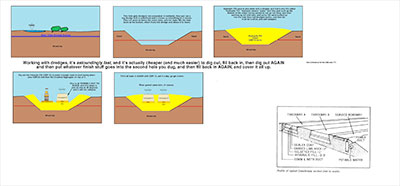 Here are his words: This hole gets dredged, not excavated. In wetlands, they just run a big dredge with cutterhead and it chews up everything as it moves. They cut down below the water table, and the water fills the hole down at the bott, which floats the dredge and allows it move. The problem is that I can't find anywhere on the web, a picture of the construction site at its beginning (where you can actually see what he describes).The only photo that comes close is this one and it is there, or I have a doubt because on the photograph one sees two kind of channels corresponding to the ways of circulation or maybe this picture was taken after the beginning of the filling operations with CBR 15 sand which will be used as foundation and that the earth in the middle is the first to emerge from the water? 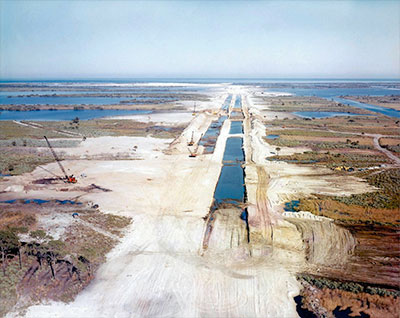 Could someone confirm or deny the statements of this person? |
Headshot
Member Posts: 1335
From: Vancouver, WA, USA
Registered: Feb 2012
|
 posted 05-22-2023 10:43 AM
posted 05-22-2023 10:43 AM
   
I was surprised to learn that the crawlerways to Pads A and B were built by different companies. There is a bit more information in the 20 June 1965 issue of Aviation Week & Space Technology, on page 85, but no details as to the construction of the crawlerways. The entire issue is devoted to the, then new, Kennedy Space Center. |
Apolloman
Member Posts: 233
From: Ledignan, Gard (30), France
Registered: Mar 2009
|
 posted 05-22-2023 11:56 AM
posted 05-22-2023 11:56 AM
   
So be careful, just a parenthesis to be clear so that there is no misunderstanding, the question is not to believe or not the person who informed me (she seemed very well informed) but it is rather the need to cross-check information from several sources if possible. |
nasamad
Member Posts: 2199
From: Essex, UK
Registered: Jul 2001
|
 posted 05-22-2023 04:46 PM
posted 05-22-2023 04:46 PM
   
I think there should be at least something about it in the NASA Special Publication titled Moonport. |
Andy Anderson
Member Posts: 124
From: Perth, Australia
Registered: Dec 2009
|
 posted 05-22-2023 07:47 PM
posted 05-22-2023 07:47 PM
   
From "The Kennedy Space Center Story" page 33. ...the Crawlerway is 40m (130ft) wide, about the width of the New Jersey Turnpike. Each lane is 12m (40ft) wide and laid out on 27 m (90 ft) center lines. To prepare the base, more than 6,000,000 cu m (8,000,000 cu yds) of fill were dredged from the adjacent Barge Channel and allowed to compact the subsoil to 95 percent density, almost the hardness of rock. This project began in November 1963 when softer and unsuitable material was replaced with the sand fill. Vibratory rollers levelled the fill which was proof rolled with 90-metric-ton (100 ton) machine. Two meters (seven ft) of graded, crushed aggregate provided the base course, above which a layer of 30 cm (12 in) of selected hydraulic fill was added. The bed was topped and sealed against moisture with an asphaltic prime coat, then covered by loose Alabama river stone 20cm (8 in) deep on curves and 150cm ( 6 in) deep on the straightway. The loose rock relieves friction on the crawler treads and is occasionally racked over with a spring harrow. The roadway was completed in August 1965. |
Blackarrow
Member Posts: 3749
From: Belfast, United Kingdom
Registered: Feb 2002
|
 posted 05-22-2023 08:19 PM
posted 05-22-2023 08:19 PM
  
I always wondered if there was some particular attribute of Alabama river stones that made them more suitable than river stones from, say, Georgia, Mississippi or Louisiana. |
Apolloman
Member Posts: 233
From: Ledignan, Gard (30), France
Registered: Mar 2009
|
 posted 05-23-2023 12:08 AM
posted 05-23-2023 12:08 AM
   
Thank you all for your feedback...But I had already done my "homework" and the information you gave me I already knew (actually what I really miss is a "visual proof" of the dredging as described by my "informant"). Even on the video entitled "The Big Challenge" (of 1967) there are very few passages concerning the construction of the crawlerway. Regarding the choice of river gravel from the Alabama River and not another one, it was chosen for its many properties: its hardness (8 on the Mohs mineral hardness scale), its roundness, its sphericity and its resistance to the LA abrasion test (Los Angeles abrasion test). I keep hoping to find a photo that really represents what I am looking for. |
GACspaceguy
Member Posts: 3103
From: Guyton, GA
Registered: Jan 2006
|
 posted 05-23-2023 04:36 AM
posted 05-23-2023 04:36 AM
   
Not wanting to change the topic (much) but the rock is Alabama River rock, so why do I see reference to Tennessee River rock? Were both used? |
garymilgrom
Member Posts: 2139
From: Atlanta, GA
Registered: Feb 2007
|
 posted 05-23-2023 05:37 AM
posted 05-23-2023 05:37 AM
   
Great thread! Learn something new every day. I've been interested in the crawlerway for half a century. 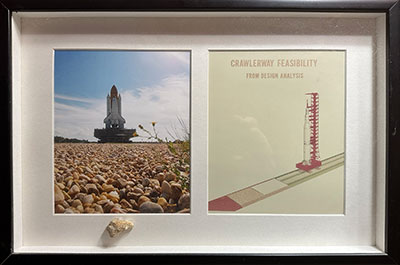 |
Joel Katzowitz
Member Posts: 889
From: Marietta GA USA
Registered: Dec 1999
|
 posted 05-23-2023 06:46 AM
posted 05-23-2023 06:46 AM
   
I've got some rocks that I'd be happy to sell you Gary!!! |
GACspaceguy
Member Posts: 3103
From: Guyton, GA
Registered: Jan 2006
|
 posted 05-23-2023 06:55 AM
posted 05-23-2023 06:55 AM
   
Saw this about the rocks, so it becomes more varied: "Rock used today still comes from Alabama and Tennessee, but from quarries, not a river, said USA engineer Bob Rokobauer." |
Apolloman
Member Posts: 233
From: Ledignan, Gard (30), France
Registered: Mar 2009
|
 posted 05-23-2023 09:15 AM
posted 05-23-2023 09:15 AM
   
It must be said that without a "super road" like the crawlerway, there would have been no departure for the Moon...And I find in my humble opinion that the structures of the Apollo program in general (except the VAB) are not well enough or not at all exposed (highlighted). So nobody has an old photo of the crawlerway dredging lying around somewhere? |
Blackarrow
Member Posts: 3749
From: Belfast, United Kingdom
Registered: Feb 2002
|
 posted 05-23-2023 09:51 AM
posted 05-23-2023 09:51 AM
  
I'm afraid I don't, but have you tried to trace the papers and records of the late Don Buchanan, who designed much of the infrastructure for Launch Complex 39? Buchanan died in 2005, but by 2001 he was disposing of many of his records. My copy of the Apollo 11 Press Kit was his personal copy. I'm guessing a lot of technical records, possibly of the kind you seek, would have been archived, or donated to technical libraries. |
garymilgrom
Member Posts: 2139
From: Atlanta, GA
Registered: Feb 2007
|
 posted 05-23-2023 10:24 AM
posted 05-23-2023 10:24 AM
   
Great point. Don won some kind of engineering award for the crawler treads. |
Apolloman
Member Posts: 233
From: Ledignan, Gard (30), France
Registered: Mar 2009
|
 posted 05-23-2023 10:31 AM
posted 05-23-2023 10:31 AM
   
I honestly wouldn't know where to start. I tried the "great classics" like Google, Google Scholar, Google Books even with a precise period and keywords. Nothing at all, almost complete nothingness.I am depressed just for the lack of interest on the subject, ah yes of course when we ask for the VAB and the LC-39A there are answers but only a few words about the crawlerway drowned in the whole... it's a shame. I even have sources but I don't know how to reach them. Examples from the Historic American Engineering Record (HAER) for the crawlerway: - "LC-39 VAB Crawlerway Surfacing." Architectural drawings, NASA KSC, May 1968. On file, Kennedy Space Center Engineering Documentation Center.
- U.S. Army Corps of Engineers, Merritt Island. "LC-39 Pad “B,” Crawlerway Surfacing; Audio/Video Cables and Miscellaneous Work, Volume 1." Architectural drawings, NASA KSC, December 1966. On file, Kennedy Space Center Engineering Documentation Center.
|
Headshot
Member Posts: 1335
From: Vancouver, WA, USA
Registered: Feb 2012
|
 posted 05-23-2023 12:36 PM
posted 05-23-2023 12:36 PM
   
Have you tried to contact the companies that constructed the crawlerways?Blount Bros Corp., and M.M. Sundt Construction Co., constructed the Pad A crawlerway and George A. Fuller Co. constructed the Pad B crawlerway. The designer of both was Giffels & Rossetti, Inc. |
Apolloman
Member Posts: 233
From: Ledignan, Gard (30), France
Registered: Mar 2009
|
 posted 05-23-2023 01:23 PM
posted 05-23-2023 01:23 PM
   
No, because my English language is too poor, it is hardly enough for the discussion forums. |
nasamad
Member Posts: 2199
From: Essex, UK
Registered: Jul 2001
|
 posted 05-23-2023 02:47 PM
posted 05-23-2023 02:47 PM
   
A search for "crawlerway construction" in Flickr yields a couple of period photos which show water in the channel.The fact there is water visible in the excavation is what prompts the name change to "dredging." The cranes in the photo showing the turn towards the pads do look like they may have drag buckets on them. The two channels make sense when you look at the scale of the project (see the cars), why dig out the centre only to refill it when it does not bear any load?  |
Andy Anderson
Member Posts: 124
From: Perth, Australia
Registered: Dec 2009
|
 posted 05-23-2023 07:25 PM
posted 05-23-2023 07:25 PM
   
Probably Apolloman you have this image already from "NASA Facts: Building KSC's Launch Complex 39," but it does show the early stages of dredging operations although there is not much detail. |
Apolloman
Member Posts: 233
From: Ledignan, Gard (30), France
Registered: Mar 2009
|
 posted 05-24-2023 07:12 AM
posted 05-24-2023 07:12 AM
   
In fact, here is the photo that made me doubt what my "informant" was saying: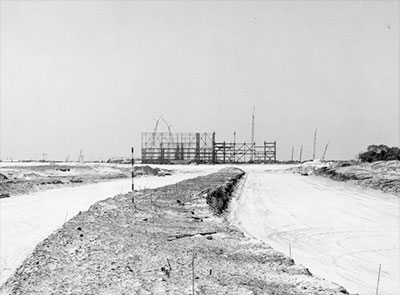 And here is the drawing that I deduced before my "informant" corrected it (very first post of the discussion). 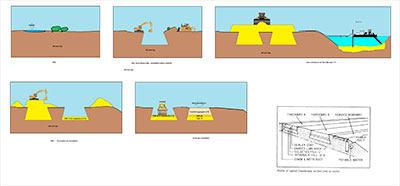 On the first picture, it looks like the strip of land in the middle strongly resembles the original terrain? What do you think? |
garymilgrom
Member Posts: 2139
From: Atlanta, GA
Registered: Feb 2007
|
 posted 05-24-2023 07:23 AM
posted 05-24-2023 07:23 AM
   
I think you're correct about the first picture but I think this is early in the construction. I assume the center part was graded (scraped until level and cleared) before it was finished. The photo in Adam's (nasamd) post seems to show this. Your English is excellent by the way. |
Apolloman
Member Posts: 233
From: Ledignan, Gard (30), France
Registered: Mar 2009
|
 posted 05-24-2023 09:37 AM
posted 05-24-2023 09:37 AM
   
On the photo in Adam's (nasamd) post, in my opinion what we see on the picture is that the workers have only placed the CBR25 sand that acts as a foundation on the CBR15 sand (subgrade), the 3 feet (base layer) of crushed aggregate are missing (I think that even small crushed aggregate/stones would show up quite well on a black and white photo (but this is just my opinion). |
garymilgrom
Member Posts: 2139
From: Atlanta, GA
Registered: Feb 2007
|
 posted 05-24-2023 12:38 PM
posted 05-24-2023 12:38 PM
   
I agree with you and think the black and white cutaway on your graphic shows this well and I agree one could see aggregate if it was there. But I don't understand your confusion. I think your graphic and the photos you and Adam have posted verify that the crawler way was dug as two trenches or channels, not one big one. I think your #2 color photo shows only ONE side of the crawler way if that's an issue. Thanks for the discussion. Salutations d'Atlanta. |
Apolloman
Member Posts: 233
From: Ledignan, Gard (30), France
Registered: Mar 2009
|
 posted 05-24-2023 12:54 PM
posted 05-24-2023 12:54 PM
   
Gary, here is, in image (it is more convenient for me) what I think from the beginning before my "informant" makes me doubt.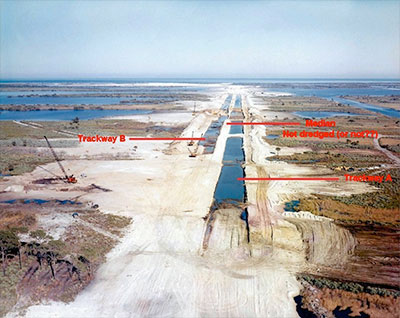 Salutations de Nîmes |
garymilgrom
Member Posts: 2139
From: Atlanta, GA
Registered: Feb 2007
|
 posted 05-24-2023 05:00 PM
posted 05-24-2023 05:00 PM
   
Thank you. From the posted photos I believe your informant was wrong and the crawler way was built / dredged as two separate roadways. |
Apolloman
Member Posts: 233
From: Ledignan, Gard (30), France
Registered: Mar 2009
|
 posted 05-25-2023 07:03 AM
posted 05-25-2023 07:03 AM
   
I found a new information concerning the crawlerway, in the book of Mr Jonathan H. Ward entitled "Rocket Ranch: The Nuts and Bolts of the Apollo Moon Program at Kennedy Space Center." On the page 167, it says: They had to excavate down, get rid of all the Florida muck, and then backfill it with good material.About a mile or a mile and a half out there along the crawlerway, there was a spot with underground water flow. In order to protect the sub-base and keep us from having a dip in the crawlerway, we had to put in sheet piles to stop the water flow across the material. |
Blackarrow
Member Posts: 3749
From: Belfast, United Kingdom
Registered: Feb 2002
|
 posted 05-25-2023 08:23 AM
posted 05-25-2023 08:23 AM
  
Anything about how Apollo got to the Moon is interesting, and it is a testament to the skill and hard work undertaken in the 1960s that the Apollo infrastructure — including that crawlerway — is still an essential element in Project Artemis. |
Apolloman
Member Posts: 233
From: Ledignan, Gard (30), France
Registered: Mar 2009
|
 posted 05-25-2023 01:47 PM
posted 05-25-2023 01:47 PM
   
quote:
Originally posted by Blackarrow:
Anything about how Apollo got to the Moon is interesting...
Indeed, I agree. |
Apolloman
Member Posts: 233
From: Ledignan, Gard (30), France
Registered: Mar 2009
|
 posted 05-27-2023 03:51 PM
posted 05-27-2023 03:51 PM
   
New info I found in the subtitles of a YouTube video. On the timing 12:45 it says: ...road to pad isn't a divided highway but two road bed filled with loose rock to help cushion the weight." What do you understand by this statement? I always come back to my first request: a single large channel dredged for the crawlerway or two channels dredged separately (one for each trackway) and the median in natural soil.I found an old photo that represents the idea I had at the beginning of my research on the subject. Here you can see the separate dredging between the pile drivers, top left. 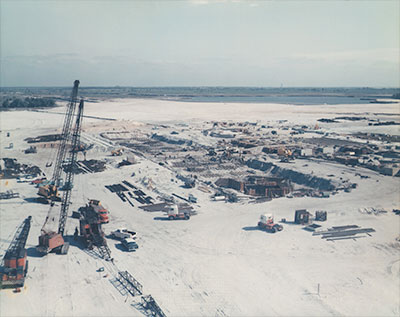 It's amazing how few images there are of the construction site in question. |
Apolloman
Member Posts: 233
From: Ledignan, Gard (30), France
Registered: Mar 2009
|
 posted 06-01-2023 04:52 AM
posted 06-01-2023 04:52 AM
   
Well, I see the discussion isn't going very well. As for me, I'm continuing my research and I've come across a really interesting clue that will change my understanding of how the engineers went about building the crawlerway.Here's a photo montage based on images of old topographical maps (1940 to 1970) found on this site:  What you can see on the "central" map (from the 60s) is that the engineers totally plugged up an arm of the Banana River with hydraulic fill to create the support for the roadway. Even the MSS parking area didn't exist originally, as well as a good part (if not all) of the launch pad. It's amazing what you can learn these days. And were you aware of this fact? |
garymilgrom
Member Posts: 2139
From: Atlanta, GA
Registered: Feb 2007
|
 posted 06-01-2023 06:13 AM
posted 06-01-2023 06:13 AM
   
I think you have proven beyond doubt that the crawler way was dredged as two separate channels or roads. Well done! |
Apolloman
Member Posts: 233
From: Ledignan, Gard (30), France
Registered: Mar 2009
|
 posted 06-01-2023 06:58 AM
posted 06-01-2023 06:58 AM
   
I wish, but I'm not quite sure.I even contacted the GBA company (Tampa) which is to be the new name of Gahagan Dredging Company. We'll see if I have any answers. |
Apolloman
Member Posts: 233
From: Ledignan, Gard (30), France
Registered: Mar 2009
|
 posted 06-07-2023 11:37 AM
posted 06-07-2023 11:37 AM
   
In the book "Rocket Ranch: The Nuts and Bolts of the Apollo Moon Program at Kennedy Space Center" it is written on page 167: About a mile or a mile and a half out there along the crawlerway, there was a spot with underground water flow. In order to protect the sub-base and keep us from having a dip in the crawlerway, we had to put in sheet piles to stop the water flow across the material. Does anyone have more information on this subject (when, where precisely on the track, how)? |
Apolloman
Member Posts: 233
From: Ledignan, Gard (30), France
Registered: Mar 2009
|
 posted 06-17-2023 03:50 AM
posted 06-17-2023 03:50 AM
   
I found a new photo of the construction of the crawlerway. Still impossible to know exactly whether it's the start of dredging the route or afterwards.Personally, I think it's the beginning (compared to the color photo of the same type posted above), as you can see the sand pyramid on pad A in the distance and a single channel on both. (source: 1964 Spaceport News Summary Final) 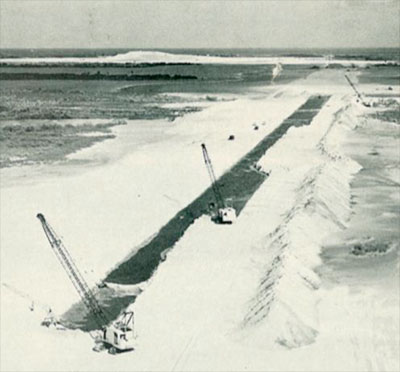 |
LM-12
Member Posts: 3981
From: Ontario, Canada
Registered: Oct 2010
|
 posted 09-05-2024 10:50 AM
posted 09-05-2024 10:50 AM
  
Is the crawlerway section between the Pad 39B turn and Pad 39A still being maintained, or has it been abandoned-in-place?
|
mgspacecadet
Member Posts: 38
From:
Registered: Apr 2012
|
 posted 09-06-2024 09:24 AM
posted 09-06-2024 09:24 AM
   
That section of crawlerway is not maintained. Only the crawlerway between the VAB and LC-39B is being maintained, for SLS use. |
LM-12
Member Posts: 3981
From: Ontario, Canada
Registered: Oct 2010
|
 posted 09-06-2024 09:39 AM
posted 09-06-2024 09:39 AM
  
Okay, thanks. I just wondered what condition that section was in. |
Blackarrow
Member Posts: 3749
From: Belfast, United Kingdom
Registered: Feb 2002
|
 posted 09-06-2024 11:16 AM
posted 09-06-2024 11:16 AM
  
You can see it by zooming in on Google Earth. It looks like there is some grass or weed growth, but it generally looks to be in OK condition (at least when imaged in 2022). It's a very short section. |
LM-12
Member Posts: 3981
From: Ontario, Canada
Registered: Oct 2010
|
 posted 09-06-2024 12:29 PM
posted 09-06-2024 12:29 PM
  
From overhead, it looks like they were removing the top layer of stones in that section of the crawlerway. |
mgspacecadet
Member Posts: 38
From:
Registered: Apr 2012
|
 posted 09-07-2024 10:37 AM
posted 09-07-2024 10:37 AM
   
Here’s a photo of that section of crawlerway, with LC39A in the background.Verified that except for the first 30 to 40 feet extending to Pad A, that section of crawlerway is not maintained. In fact pretty much all of the upper layer of river rock is gone. 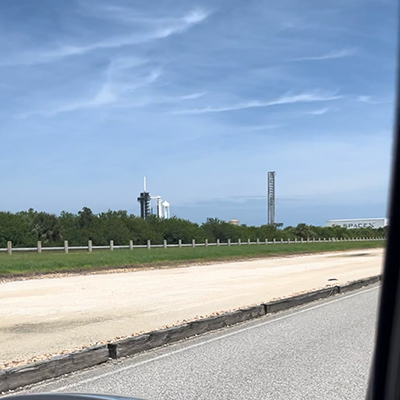 |























